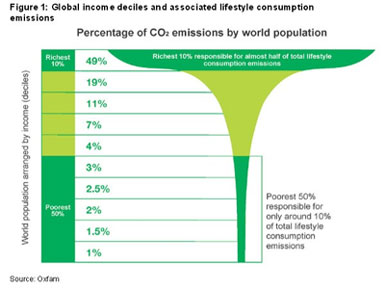In the US, one of the major themes in our presidential campaign is income inequality between the richest 1% and the rest of our citizens. Not suprisingly, this theme also applies to climate change.
Oxfam‘s new report – released at COP21 – lays bare "climate-change inequality": the world’s richest 1% are also the biggest polluters by far, producing 175 times the carbon emissions as people in the bottom 10% of income.
The richest 10% are responsible for half the world’s emissions, while the poorest half – roughly 3.5 billion people – produce only 10% of all emissions.

And the poor are – and will – be most negatively affected by climate change. They can’t move to safer ground or even insulate their homes the way rich people can. They tend to live in countries with the least capacity to adapt.
"Climate change and economic inequality are inextricably linked and together pose one of the greatest challenges of the 21st century," says Tim Gore of Oxfam.
Another report, "Carbon and Inequality: From Kyoto to Paris" comes to the same conclusion. "It is the rich Europeans, Americans and Chinese that emit the most carbon, while the emissions from the world’s poorest citizens are falling. The richest 1% of Americans, Luxembourgers, Singaporeans and Saudis emit more than 200 tonnes of carbon per person per year; 2,000 times more than the poorest in Honduras, Rwanda or Malawi," says author French economist Thomas Piketty (who wrote the best seller, "Capital").
Both Oxfam and Pikkety conclude the rich should be held accountable for emissions, no matter where they live.
Oxfam points out that the super rich in developing countries like China, India, Brazil and South Africa have
high and rapidly rising emissions, but are still "behind" their advanced country counterparts .. and they will soon catch up.
Oxfam says:
"While the richest citizens can and should contribute as individuals to cutting their own emissions through lifestyle changes, wherever they live, they can’t solve the climate crisis through voluntary action alone. Their choices are often constrained by the decisions of their governments in all sorts of areas, from energy to transport policy.
"Without question, a weak agreement in Paris is no more in their interests than it is in the interests of the poorest and least responsible. Increasingly members of the richest 10% are experiencing the impacts of climate change themselves, and are mobilizing to demand action
from their governments.
"The only beneficiaries of inadequate climate action in Paris and beyond are a much smaller elite with vested interests in the continuation of a high carbon and deeply unequal global economy. The number of billionaires
with interests in fossil fuel activities has risen from 54 n 2010 to 88 in 2015, while the size of their combined personal fortunes has expanded by around 50% from over $200 billion to more than $300 billion."
Green Climate Fund
Perhaps you can understand then, why poor nations demand financial assistance from advanced nations, which are responsible for the lionshare of emissions.
Poor nations haven’t caused the problem but they are most vulnerable to it. They need help to adapt so their people can live.
And the world can’t afford ANY more emissions, so developing countries must get assistance to leap frog to renewable energy instead of using coal.
Therefore, a major goal of COP21 is to get the financing established to do this, instead of allowing a conflict between rich and poor to derail an international agreement as it has done in the past.
Accelerating natural disasters already impacts hundreds of millions of people a year. The Rockefeller Foundation estimates that $1 out of every $3 spent on development is lost to these recurring crises – a total $3.8 trillion worldwide. Resilient societies would suffer less and recover more quickly.
So far at COP21, initiatives adding up to $1 billion have been mobilized:
- a coalition will develop early warning systems for over 50 of the least developed countries and small island states by 2020: Climate Risks and Early Warning Systems (CREWS).
- Provide access to insurance to 400 million vulnerable people in 5 years: G7 InsuResilience Initiative.
- Great Green Wall for the Sahara and Sahel Initiative: a wall of trees is being planted across the southern edge of the Sahara desert – across the African continent – to prevent desertification from advancing. It reinvigorates soil and brings back ecosystems, improving food security and rural communities. The World Bank will invest $2.2 billion.
- Global Resilience Partnership is raising funds to invest in innovative resilience measures over the next five years, starting in areas in Africa and Southeast Asia.
- "A2R" (Anticipate, Absorb, Reshape) will build climate resilience in the world’s most vulnerable countries by strengthening their ability to anticipate hazards, absorb shocks by increasing insurance and social protection coverage, and reshape development to reduce climate risks. It will address the needs of nearly 634 million people who live in risk-prone coastal areas and areas at risk from droughts and floods.
Read Oxfam’s report, "Extreme Carbon Inequality":
